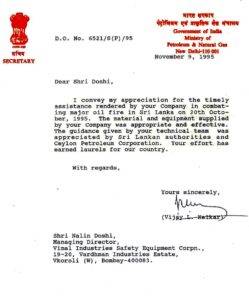Introduction
In the world of fire safety, preparation is paramount. When lives, assets, and businesses are at stake, there is no room for error. Recognizing the critical need for comprehensive training, Vimal Fire Controls established the IMSAFE Academy, a state-of-the-art training facility dedicated to equipping professionals with the skills and knowledge needed to handle real-world fire emergencies. This blog delves into the heart of the IMSAFE Academy’s live fire fighting programs, exploring their structure, significance, and the profound impact they have on enhancing safety and readiness.
The Genesis of IMSAFE Academy
Vision and Mission
The IMSAFE Academy was born out of a vision to create a safer world by training individuals to respond effectively to fire emergencies. With a mission to save lives and protect assets, the academy offers a range of programs that blend theoretical knowledge with practical, hands-on experience. Located near Vadodara, Gujarat, this NSDC-approved training facility stands as a beacon of excellence in fire safety education.
The Need for Specialized Training
The complex and evolving nature of fire hazards in industrial, commercial, and residential settings necessitates specialized training. Firefighters and safety professionals must be adept at using advanced equipment, understanding fire dynamics, and executing strategic responses. IMSAFE Academy addresses these needs by providing targeted training that prepares individuals for the unique challenges posed by different fire scenarios.
Comprehensive Training Programs
Curriculum Overview
The IMSAFE Academy’s curriculum is meticulously designed to cover all aspects of fire safety and disaster management. From basic fire fighting techniques to advanced response strategies, the programs cater to a wide range of participants, including industrial workers, emergency responders, and safety officers.
- Basic Fire Fighting Training
- Introduction to Fire Safety: Understanding the basics of fire, including its chemistry, types, and behavior. Trainees learn about the fire tetrahedron (fuel, heat, oxygen, and chemical chain reaction) and how disrupting any of these elements can extinguish a fire.
- Use of Fire Extinguishers: Hands-on training with various types of extinguishers, including water, foam, and CO2. Participants practice the PASS technique (Pull, Aim, Squeeze, Sweep) to ensure effective extinguisher use.
- Evacuation Procedures: Learning effective evacuation strategies to ensure safe and orderly exits during emergencies. This includes understanding evacuation routes, assembly points, and the role of fire wardens.
- Advanced Fire Fighting Training
- Fire Fighting Equipment: Detailed instruction on the use of advanced equipment such as SHOOTFIRE foam monitors and fire fighting robots. Trainees operate high-capacity foam monitors and understand their applications in different fire scenarios.
- Live Fire Drills: Simulated fire scenarios that replicate real-life conditions, providing trainees with invaluable experience in handling actual fires. These drills include controlled burns in mock setups, enabling participants to practice attack strategies and water application techniques.
- Rescue Operations: Techniques for rescuing individuals trapped in fire-affected areas, emphasizing the importance of teamwork and coordination. This module covers search and rescue methods, the use of thermal imaging cameras, and victim stabilization.
- Specialized Training Modules
- Hazardous Materials Handling: Training on the safe handling and disposal of hazardous materials to prevent fire risks. Trainees learn about the properties of various hazardous substances, proper storage practices, and emergency response procedures for chemical spills and fires.
- Emergency Response Planning: Developing and implementing comprehensive emergency response plans tailored to specific industrial settings. This includes risk assessment, resource allocation, and coordination with local emergency services.
- Disaster Management: Preparing for large-scale disasters, including natural calamities and industrial accidents, with a focus on mitigation and recovery strategies. Participants learn about incident command systems, communication protocols, and the importance of community preparedness.
State-of-the-Art Training Facilities
Realistic Fire Simulations
One of the hallmarks of the IMSAFE Academy is its ability to create realistic fire simulations. The training ground is equipped with various mock setups, including industrial plants, residential buildings, and commercial spaces. These setups are designed to mimic real-world conditions, providing trainees with a safe yet challenging environment to practice their skills.
- Industrial Mock-ups: These include replicas of factories and warehouses with complex layouts, allowing trainees to navigate and manage fire incidents in large, confined spaces.
- Residential and Commercial Setups: Simulated apartment complexes, office buildings, and shopping centers help trainees understand fire dynamics in multi-story structures and develop effective evacuation strategies.
- Specialized Training Areas: Dedicated zones for high-risk scenarios, such as chemical plants and oil refineries, provide a controlled environment for handling hazardous materials and complex fire incidents.
Advanced Training Equipment
The academy boasts a wide array of advanced training equipment, ensuring that participants are familiar with the latest fire fighting technologies. This includes:
- SHOOTFIRE Foam Monitors: Trainees learn to operate different models of these high-capacity foam monitors, essential for combating large-scale fires. They practice deploying foam streams and adjusting flow rates to effectively suppress fires.
- Fire Fighting Robots: The use of robots in fire fighting is a game-changer, and trainees at IMSAFE get hands-on experience with these cutting-edge machines. They learn to control robots remotely, navigate through hazardous environments, and operate water cannons or other suppression tools.
- Aspirating Smoke Detection Systems: Understanding and using early warning systems that detect smoke before it becomes a major hazard. Trainees install and maintain these systems, ensuring they are prepared to identify and respond to potential fire threats early.
The Importance of Live Fire Training
Bridging the Gap Between Theory and Practice
Live fire training is crucial in bridging the gap between theoretical knowledge and practical application. While classroom learning provides the foundational concepts of fire safety, it is the hands-on experience that truly prepares individuals for real-world emergencies. At IMSAFE Academy, trainees face controlled fire scenarios that test their skills, decision-making abilities, and composure under pressure.
- Scenario-Based Training: Realistic scenarios, such as electrical fires, flammable liquid fires, and structural fires, challenge trainees to apply their knowledge and adapt to dynamic situations.
- Decision-Making Under Pressure: Trainees learn to make quick, informed decisions in high-stress environments, ensuring they can act effectively when seconds count.
Building Confidence and Competence
Facing a live fire scenario can be intimidating, but it is this exposure that builds confidence and competence. Through repeated drills and exercises, trainees become more adept at handling fire emergencies, making them more effective in their roles. This confidence is vital, as it ensures that they can act swiftly and decisively when real fires occur.
- Muscle Memory and Reflexes: Repeated practice ingrains essential skills and reflexes, enabling trainees to react instinctively in emergencies.
- Team Coordination: Live fire drills emphasize the importance of teamwork, communication, and coordination, ensuring that all team members work seamlessly together during a crisis.
Testimonials and Success Stories
Transformative Experiences
The impact of IMSAFE Academy’s training programs is best reflected in the testimonials of those who have undergone the training. Many participants speak of transformative experiences, where the rigorous training not only enhanced their skills but also instilled a profound sense of responsibility and preparedness.
One such testimonial comes from Rajesh Kumar, a safety officer at a major industrial plant. “The training at IMSAFE Academy was a game-changer for me,” he says. “The live fire drills were intense, but they prepared me for the worst-case scenarios. I now feel confident that I can protect my colleagues and ensure their safety during an emergency.”
Another success story involves Anjali Patel, an emergency responder. “Before attending IMSAFE Academy, I had never faced a live fire. The experience was eye-opening and incredibly valuable. The instructors were knowledgeable and supportive, and the training environment was as close to real-life as it gets. I’m now better equipped to handle fire emergencies, both physically and mentally.”
Real-World Applications
The true test of any training program is its application in real-world situations. Graduates of the IMSAFE Academy have gone on to handle numerous fire emergencies, preventing potential disasters and saving lives. Their stories of bravery and quick thinking are a testament to the effectiveness of the training they received.
For instance, a team of IMSAFE-trained firefighters successfully managed a major fire at a chemical plant, containing the blaze before it could cause significant damage. Their quick response and strategic use of foam monitors were pivotal in averting a catastrophe.
Conclusion
In the realm of fire safety, preparation is not just an advantage—it is a necessity. The IMSAFE Academy, with its comprehensive and rigorous training programs, plays a pivotal role in preparing individuals to face fire emergencies with confidence and competence. By blending theoretical knowledge with practical experience, the academy ensures that its trainees are not just knowledgeable, but also capable of making a real difference in critical situations.
As we continue to advance in fire safety technology, the importance of thorough and realistic training cannot be overstated. The IMSAFE Academy stands as a shining example of excellence in this field, dedicated to creating a safer world, one trained professional at a time. The academy’s commitment to innovation, realism, and excellence ensures that it will remain at the forefront of fire safety training, continuously evolving to meet the challenges of tomorrow’s fire emergencies.



